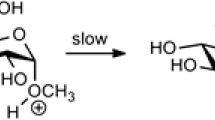Abstract
Cellulose substituted by organosilicon groups represents a new type of modified cellulose. The silylation changes the physical and chemical properties of cellulose drastically. The thermoanalytical investigation of differently trimethylsilylated cellulose derivatives was carried out under static conditions in air atmosphere. The DTA curves of the cellulose used as starting material are different from those of its silylated derivatives. In the latter a new characteristic exothermic peak appears in the range 320–370°. The value of this maximum depends on the grade of silylation, being shifted towards higher temperatures with higher degrees of substitution.
Résumé
La cellulose substituée par des groupes silico-organiques représente un nouveau type de celluloses modifiées. La présence du silicium change complètement les caractéristiques physiques et chimiques de la cellulose. L'étude thermo-analytique de divers dérivés de la cellulose triméthylsilylée a été effectuée dans l'air en atmosphère statique. Les courbes ATD de la cellulose utilisée comme matériau de départ sont différentes de celles de ses dérivés silylés. Pour ceux-ci, un nouveau pic exothermique caractéristique apparaît entre 320 et 370°C. La température du maximum du pic dépend du degré de la silylation et se déplace vers les valeurs plus élevées si le degré de substitution augmente.
Zusammenfassung
Die durch Organosilikongruppen substituierte Zellulose stellt einen neuen Typ modifizierter Zellulose dar. Die Silylierung ändert die physikalischen und chemischen Eigenschaften der Zellulose drastisch. Die thermoanalytische Prüfung verschieden trimethylsilylierter Zellulosederivate wurde in Luft unter statischen Bedingungen durchgeführt. Die DTA-Kurven der als Ausgangsmaterial eingesetzten Zellulose sind von denen ihrer Silylderivate verschieden. In den letzteren erscheint ein neuer charakteristischer exothermer Peak im Bereich von 320 bis 370°C. Die Temperaturlage dieses Maximums hängt vom Silylierungsgrad ab und wird bei höherem Substitutionsgrad in Richtung höherer Temperaturen verschoben.
Резюме
Введение кремний—ор ганических групп в целлюлозу дает новый тип модифицированно й целлюлозы. Наличие та ких групп сильно изме няет физические и химичес кие свойства целлюлозы. В статических условия х в атмосфере воздуха бы ло проведено термоан алитическое исследование целлюл озы с различной степе нью замещения триметилс илильными группами. Кривые DTA целл юлозы, используемой в качестве исходного материала, отличаются от кривых ее силильных произво дных. Для последных появляетс я новый характерный экзотермический пик в области 320–370°C. Значени е этого максимума зависит от степени силилиров ания и сдвигается в бо лее высокотемпературну ю область с увеличени ем степени замещения.
Similar content being viewed by others
References
G. Hornuff andH. J. Jakobasch, Faserforsch. Textiltech., 18 (1967) 282.
G. Hornuff andR. Schäfer, Deutsche Textiltechnik, 18 (1968) 110.
G. Hornuff andR. Schäfer, Faserforsch. Textiltech., 23 (1972) 466.
J. Nagy, K. Becker-Pálossy, A. Borbély-Kuszmann andE. Zimonyi-Hegedü s, Periodica Polytech., 18 (1974) 91.
Author information
Authors and Affiliations
Rights and permissions
About this article
Cite this article
Borbély-Kuszmann, A., Brandt-Petrik, E., Liptay, G. et al. Thermooxidative investigation of silylated cellulose derivatives. Journal of Thermal Analysis 10, 59–64 (1976). https://doi.org/10.1007/BF02179190
Received:
Issue Date:
DOI: https://doi.org/10.1007/BF02179190




